综合英语教案
- 格式:doc
- 大小:118.50 KB
- 文档页数:11
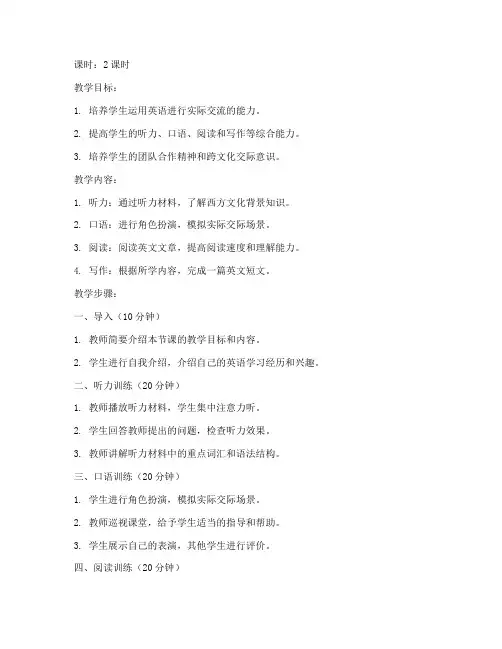
课时:2课时教学目标:1. 培养学生运用英语进行实际交流的能力。
2. 提高学生的听力、口语、阅读和写作等综合能力。
3. 培养学生的团队合作精神和跨文化交际意识。
教学内容:1. 听力:通过听力材料,了解西方文化背景知识。
2. 口语:进行角色扮演,模拟实际交际场景。
3. 阅读:阅读英文文章,提高阅读速度和理解能力。
4. 写作:根据所学内容,完成一篇英文短文。
教学步骤:一、导入(10分钟)1. 教师简要介绍本节课的教学目标和内容。
2. 学生进行自我介绍,介绍自己的英语学习经历和兴趣。
二、听力训练(20分钟)1. 教师播放听力材料,学生集中注意力听。
2. 学生回答教师提出的问题,检查听力效果。
3. 教师讲解听力材料中的重点词汇和语法结构。
三、口语训练(20分钟)1. 学生进行角色扮演,模拟实际交际场景。
2. 教师巡视课堂,给予学生适当的指导和帮助。
3. 学生展示自己的表演,其他学生进行评价。
四、阅读训练(20分钟)1. 学生阅读英文文章,了解文章大意。
2. 教师提问,检查学生对文章的理解程度。
3. 学生总结文章的主要观点,分享自己的看法。
五、写作训练(20分钟)1. 教师讲解写作技巧,指导学生完成一篇英文短文。
2. 学生根据自己的兴趣和所学内容,撰写短文。
3. 教师巡视课堂,给予学生适当的指导和帮助。
六、总结与反馈(10分钟)1. 学生展示自己的作品,其他学生进行评价。
2. 教师对本节课的教学内容进行总结,并对学生的表现给予评价。
3. 学生分享自己的学习心得,提出改进意见。
教学评价:1. 听力部分:根据学生回答问题的准确率进行评价。
2. 口语部分:根据学生的表演和互动情况进行评价。
3. 阅读部分:根据学生的阅读速度和理解程度进行评价。
4. 写作部分:根据学生的写作内容、结构和语法错误进行评价。
教学反思:本节课通过听力、口语、阅读和写作等多种教学形式,培养学生的英语综合能力。
在教学过程中,教师应注重激发学生的学习兴趣,提高学生的参与度。
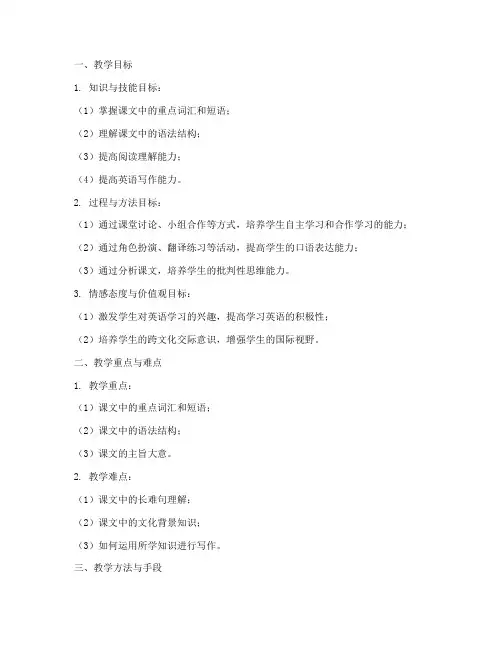
一、教学目标1. 知识与技能目标:(1)掌握课文中的重点词汇和短语;(2)理解课文中的语法结构;(3)提高阅读理解能力;(4)提高英语写作能力。
2. 过程与方法目标:(1)通过课堂讨论、小组合作等方式,培养学生自主学习和合作学习的能力;(2)通过角色扮演、翻译练习等活动,提高学生的口语表达能力;(3)通过分析课文,培养学生的批判性思维能力。
3. 情感态度与价值观目标:(1)激发学生对英语学习的兴趣,提高学习英语的积极性;(2)培养学生的跨文化交际意识,增强学生的国际视野。
二、教学重点与难点1. 教学重点:(1)课文中的重点词汇和短语;(2)课文中的语法结构;(3)课文的主旨大意。
2. 教学难点:(1)课文中的长难句理解;(2)课文中的文化背景知识;(3)如何运用所学知识进行写作。
三、教学方法与手段1. 教学方法:启发式教学、讨论法、小组合作法、角色扮演法、翻译练习法等。
2. 教学手段:多媒体课件、黑板、实物教具等。
四、教学过程1. 导入新课(1)利用图片、视频等导入与课文主题相关的背景知识;(2)引导学生回顾上节课所学内容,为新课做好铺垫。
2. 讲授新课(1)讲解课文中的重点词汇和短语,并进行例句展示;(2)分析课文中的语法结构,并进行讲解;(3)讲解课文的主旨大意,引导学生理解课文内容。
3. 课堂活动(1)小组讨论:针对课文中的某个问题进行讨论,培养学生的合作学习能力;(2)角色扮演:让学生扮演课文中的角色,提高学生的口语表达能力;(3)翻译练习:将课文中的段落进行翻译,提高学生的翻译能力。
4. 巩固练习(1)完成课后练习题,巩固所学知识;(2)小组合作,互相检查练习题答案,提高学生的自主学习能力。
5. 归纳小结(1)回顾本节课所学内容,总结重点;(2)布置课后作业,包括阅读、写作和翻译等。
6. 作业布置(1)阅读课文,完成课后练习题;(2)根据课文内容,写一篇短文,题目自拟;(3)将课文中的某个段落进行翻译。
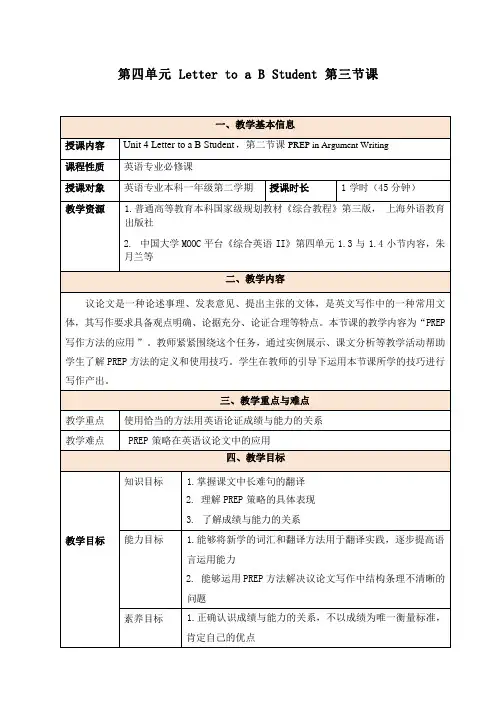
教学内容
教学活动
教学手段
教学方法
设计意图教师学生
1.学习慕课《综合英语II》第四单元 1.5 和 1.6 小节内容
2. 完成线上翻译练习
3. 阅读PISA 测评报告及英语课外阅读文章“Do Grades Measure Intelligence? ”回答问发布线上学习资
料,布置线上任
务,并关注学习
平台动态,与学
生线上互动
自主完成学
习任务,并
在学习讨论
区参与讨论
:
慕课平台
学习、班级
qq 群、雨课
堂学习
自主学习
通过课前自主
学习让学生理
解本单元课文
中的长难句,
并将其运用到
翻译训练中
将PREP 策略用于小组活动实践。
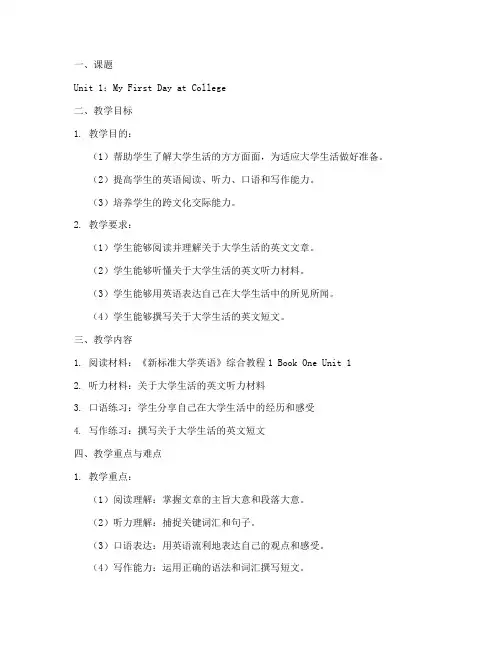
一、课题Unit 1:My First Day at College二、教学目标1. 教学目的:(1)帮助学生了解大学生活的方方面面,为适应大学生活做好准备。
(2)提高学生的英语阅读、听力、口语和写作能力。
(3)培养学生的跨文化交际能力。
2. 教学要求:(1)学生能够阅读并理解关于大学生活的英文文章。
(2)学生能够听懂关于大学生活的英文听力材料。
(3)学生能够用英语表达自己在大学生活中的所见所闻。
(4)学生能够撰写关于大学生活的英文短文。
三、教学内容1. 阅读材料:《新标准大学英语》综合教程1 Book One Unit 12. 听力材料:关于大学生活的英文听力材料3. 口语练习:学生分享自己在大学生活中的经历和感受4. 写作练习:撰写关于大学生活的英文短文四、教学重点与难点1. 教学重点:(1)阅读理解:掌握文章的主旨大意和段落大意。
(2)听力理解:捕捉关键词汇和句子。
(3)口语表达:用英语流利地表达自己的观点和感受。
(4)写作能力:运用正确的语法和词汇撰写短文。
2. 教学难点:(1)词汇理解:掌握与大学生活相关的词汇。
(2)语法运用:正确运用英语语法知识。
(3)跨文化交际:了解西方文化背景,提高跨文化交际能力。
五、教学过程1. 导入新课(1)教师简要介绍大学生活的相关背景,激发学生的学习兴趣。
(2)提问:学生对自己大学生活有什么期待?2. 阅读教学(1)学生阅读课文,了解文章主旨大意。
(2)教师讲解文章中的生词、短语和语法结构。
(3)学生分组讨论,分享阅读心得。
3. 听力教学(1)学生听关于大学生活的英文听力材料,捕捉关键词汇和句子。
(2)教师总结听力材料中的主要内容,并引导学生进行复述。
4. 口语练习(1)学生分组讨论,分享自己在大学生活中的经历和感受。
(2)教师鼓励学生用英语表达自己的观点,并给予适当的评价和指导。
5. 写作教学(1)学生根据课文内容,撰写关于大学生活的英文短文。
(2)教师批改作文,指出学生的优点和不足,并进行针对性指导。

1. 知识目标:- 学生能够理解课文的主要内容和结构。
- 掌握与食物相关的关键词汇和表达方式。
- 熟悉描述个人情感的表达方式。
- 掌握文中的一些语法点。
2. 能力目标:- 提高阅读技能:包括文本评估、略读和扫读。
- 扩展词汇量,尤其是与食物相关的词汇。
- 提升写作和认知能力。
3. 情感目标:- 培养学生对食物文化的兴趣。
- 鼓励学生积极参与课堂活动,培养合作精神。
#### 教学重点:- 课文内容理解和分析。
- 阅读技能的培养。
- 词汇和表达方式的掌握。
#### 教学难点:- 文中复杂句型的理解和运用。
- 阅读速度和效率的提高。
#### 教学准备:- 教师准备:PPT课件、课文朗读录音、词汇卡片、角色扮演剧本。
- 学生准备:预习课文,准备角色扮演。
##### 第一课时1. 导入(5分钟):- 通过提问学生关于食物的话题,如“你最喜欢的食物是什么?”等,激发学生的学习兴趣。
2. 课文阅读(20分钟):- 学生自主阅读课文,教师朗读课文,并讲解重点词汇和表达方式。
- 学生跟读课文,注意语音、语调。
3. 小组讨论(15分钟):- 学生分组讨论课文内容,分享对文章的理解和感受。
- 教师巡回指导,帮助学生解决疑问。
4. 总结与反馈(10分钟):- 教师总结本节课的主要内容,强调重点和难点。
- 学生反馈学习收获,提出疑问。
##### 第二课时1. 复习与巩固(10分钟):- 通过游戏或练习,复习上一节课的重点词汇和表达方式。
2. 阅读技能训练(20分钟):- 学生练习略读和扫读,找出文章的关键信息。
- 教师讲解阅读技巧,如快速定位、关键词搜索等。
3. 角色扮演(20分钟):- 学生分组进行角色扮演,模拟课文中的场景。
- 教师观察并给予指导。
4. 写作练习(10分钟):- 学生根据课文内容,撰写一篇关于食物的短文。
- 教师批改并给予反馈。
#### 教学反思:- 本节课通过多种教学方法,如小组讨论、角色扮演等,激发了学生的学习兴趣,提高了学生的阅读和写作能力。
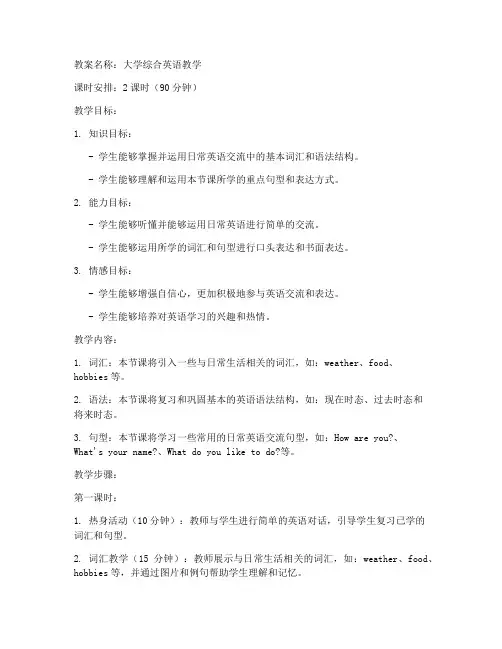
教案名称:大学综合英语教学课时安排:2课时(90分钟)教学目标:1. 知识目标:- 学生能够掌握并运用日常英语交流中的基本词汇和语法结构。
- 学生能够理解和运用本节课所学的重点句型和表达方式。
2. 能力目标:- 学生能够听懂并能够运用日常英语进行简单的交流。
- 学生能够运用所学的词汇和句型进行口头表达和书面表达。
3. 情感目标:- 学生能够增强自信心,更加积极地参与英语交流和表达。
- 学生能够培养对英语学习的兴趣和热情。
教学内容:1. 词汇:本节课将引入一些与日常生活相关的词汇,如:weather、food、hobbies等。
2. 语法:本节课将复习和巩固基本的英语语法结构,如:现在时态、过去时态和将来时态。
3. 句型:本节课将学习一些常用的日常英语交流句型,如:How are you?、What's your name?、What do you like to do?等。
教学步骤:第一课时:1. 热身活动(10分钟):教师与学生进行简单的英语对话,引导学生复习已学的词汇和句型。
2. 词汇教学(15分钟):教师展示与日常生活相关的词汇,如:weather、food、hobbies等,并通过图片和例句帮助学生理解和记忆。
3. 语法复习(20分钟):教师通过例句和练习题帮助学生复习和巩固基本的英语语法结构,如:现在时态、过去时态和将来时态。
4. 句型学习(15分钟):教师展示一些常用的日常英语交流句型,如:How are you?、What's your name?、What do you like to do?等,并通过角色扮演和小组活动帮助学生进行口头表达和交流。
第二课时:1. 复习和回顾(10分钟):教师通过问答和练习题帮助学生复习和巩固上节课所学的词汇、语法和句型。
2. 听力练习(15分钟):教师播放一段英语对话或短文,要求学生听懂并能够回答相关问题。
3. 口头表达和交流(20分钟):教师组织学生进行小组活动,要求学生运用所学的词汇和句型进行口头表达和交流,如:介绍自己的兴趣爱好、询问他人的喜好等。
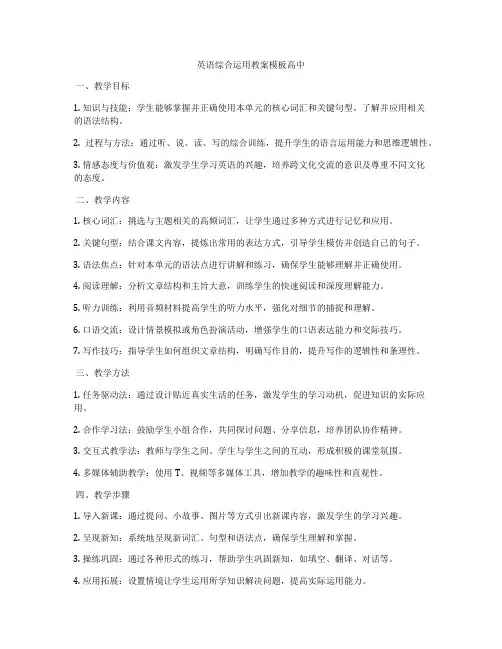
英语综合运用教案模板高中一、教学目标1. 知识与技能:学生能够掌握并正确使用本单元的核心词汇和关键句型,了解并应用相关的语法结构。
2. 过程与方法:通过听、说、读、写的综合训练,提升学生的语言运用能力和思维逻辑性。
3. 情感态度与价值观:激发学生学习英语的兴趣,培养跨文化交流的意识及尊重不同文化的态度。
二、教学内容1. 核心词汇:挑选与主题相关的高频词汇,让学生通过多种方式进行记忆和应用。
2. 关键句型:结合课文内容,提炼出常用的表达方式,引导学生模仿并创造自己的句子。
3. 语法焦点:针对本单元的语法点进行讲解和练习,确保学生能够理解并正确使用。
4. 阅读理解:分析文章结构和主旨大意,训练学生的快速阅读和深度理解能力。
5. 听力训练:利用音频材料提高学生的听力水平,强化对细节的捕捉和理解。
6. 口语交流:设计情景模拟或角色扮演活动,增强学生的口语表达能力和交际技巧。
7. 写作技巧:指导学生如何组织文章结构,明确写作目的,提升写作的逻辑性和条理性。
三、教学方法1. 任务驱动法:通过设计贴近真实生活的任务,激发学生的学习动机,促进知识的实际应用。
2. 合作学习法:鼓励学生小组合作,共同探讨问题、分享信息,培养团队协作精神。
3. 交互式教学法:教师与学生之间、学生与学生之间的互动,形成积极的课堂氛围。
4. 多媒体辅助教学:使用T、视频等多媒体工具,增加教学的趣味性和直观性。
四、教学步骤1. 导入新课:通过提问、小故事、图片等方式引出新课内容,激发学生的学习兴趣。
2. 呈现新知:系统地呈现新词汇、句型和语法点,确保学生理解和掌握。
3. 操练巩固:通过各种形式的练习,帮助学生巩固新知,如填空、翻译、对话等。
4. 应用拓展:设置情境让学生运用所学知识解决问题,提高实际运用能力。
5. 总结反馈:回顾本节课重点内容,及时给予学生反馈,强化记忆效果。
五、评价方式1. 过程评价:关注学生在课堂上的表现,包括参与度、合作态度、语言运用情况等。
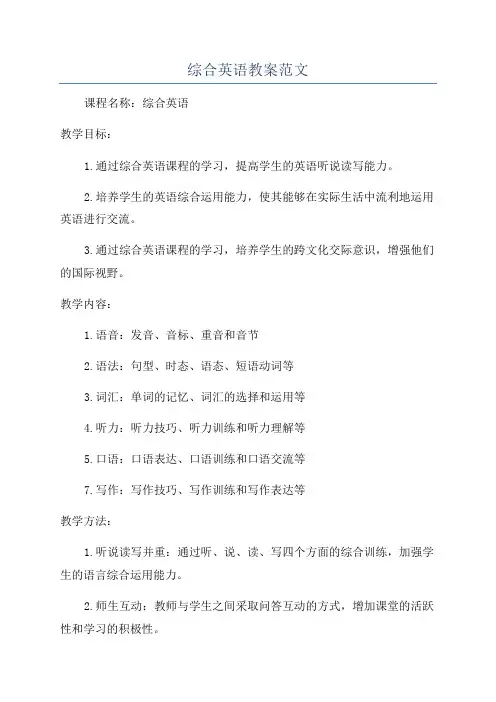
综合英语教案范文课程名称:综合英语教学目标:1.通过综合英语课程的学习,提高学生的英语听说读写能力。
2.培养学生的英语综合运用能力,使其能够在实际生活中流利地运用英语进行交流。
3.通过综合英语课程的学习,培养学生的跨文化交际意识,增强他们的国际视野。
教学内容:1.语音:发音、音标、重音和音节2.语法:句型、时态、语态、短语动词等3.词汇:单词的记忆、词汇的选择和运用等4.听力:听力技巧、听力训练和听力理解等5.口语:口语表达、口语训练和口语交流等7.写作:写作技巧、写作训练和写作表达等教学方法:1.听说读写并重:通过听、说、读、写四个方面的综合训练,加强学生的语言综合运用能力。
2.师生互动:教师与学生之间采取问答互动的方式,增加课堂的活跃性和学习的积极性。
3.小组讨论:将学生分成小组,进行语言交流和合作学习,培养学生的合作精神和团队意识。
4.案例分析:通过分析实际生活中的案例,引导学生进行讨论和思考,培养他们的综合分析能力。
教学步骤:Step 1:导入(10分钟)在导入环节,教师可以通过一段短视频或图片展示来激发学生的兴趣,引入本节课的主题。
Step 2:学习新知(30分钟)教师可以通过PPT或板书讲解本节课的重点内容,如音标、语法规则、词汇选择等。
同时,教师可以进行一些例句的分析和讲解,帮助学生理解和记忆。
Step 3:合作学习(20分钟)将学生分成小组,让他们合作进行一些口语练习、听力训练或阅读理解等任务。
教师在这个环节可以进行一对一的帮助和指导,加强学生的学习效果。
Step 4:案例分析(20分钟)教师可以选择一个实际生活中的案例,引导学生进行分析和讨论。
例如,学生可以讨论如何在海外旅行中与当地人交流、如何在跨文化环境中展示自己的优势等。
Step 5:练习与巩固(15分钟)让学生进行一些课堂练习,如填空、改错、问答题等,巩固本节课所学内容。
同时,教师可以布置一些课后作业,让学生在家继续加强学习。
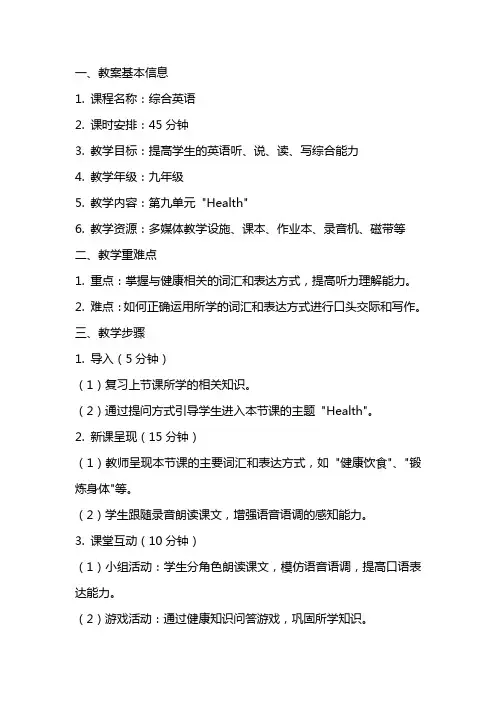
一、教案基本信息1. 课程名称:综合英语2. 课时安排:45分钟3. 教学目标:提高学生的英语听、说、读、写综合能力4. 教学年级:九年级5. 教学内容:第九单元"Health"6. 教学资源:多媒体教学设施、课本、作业本、录音机、磁带等二、教学重难点1. 重点:掌握与健康相关的词汇和表达方式,提高听力理解能力。
2. 难点:如何正确运用所学的词汇和表达方式进行口头交际和写作。
三、教学步骤1. 导入(5分钟)(1)复习上节课所学的相关知识。
(2)通过提问方式引导学生进入本节课的主题"Health"。
2. 新课呈现(15分钟)(1)教师呈现本节课的主要词汇和表达方式,如"健康饮食"、"锻炼身体"等。
(2)学生跟随录音朗读课文,增强语音语调的感知能力。
3. 课堂互动(10分钟)(1)小组活动:学生分角色朗读课文,模仿语音语调,提高口语表达能力。
(2)游戏活动:通过健康知识问答游戏,巩固所学知识。
4. 作业布置(5分钟)(1)课后作业:完成课本配套练习题,巩固所学知识。
(2)拓展作业:调查家人或朋友的健康习惯,并用英语进行简要汇报。
四、课后反思(5分钟)教师对本节课的教学效果进行自我评价,找出不足之处,为下一节课的教学做好准备。
五、教学评价1. 学生课堂参与度:观察学生在课堂上的发言和互动情况,了解学生的学习积极性。
2. 学生作业完成情况:检查课后作业,评估学生的学习效果。
3. 学生单元测试成绩:通过单元测试,检验学生的综合运用能力。
六、教学评价方式1. 口语表达:评估学生在课堂互动中的口语表达流利程度、准确性和语音语调。
2. 听力理解:通过课后练习和课堂小测试,检测学生对听力材料的理解程度。
3. 阅读理解:评估学生对课文内容的理解和分析能力,以及词汇的运用。
4. 写作能力:通过课后作业和课堂练习,评价学生的写作技巧和语言组织能力。
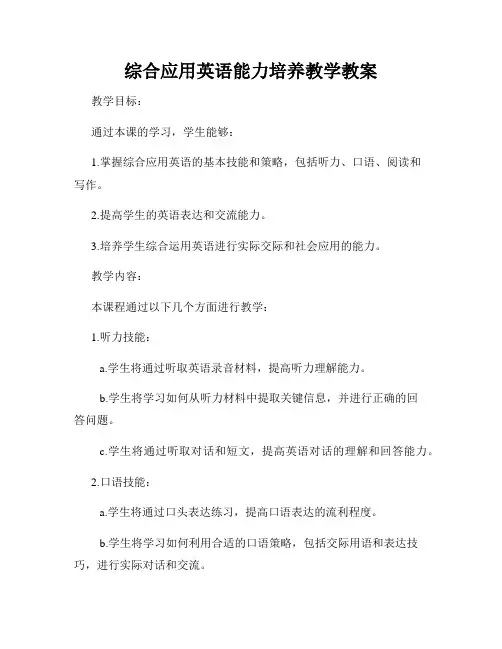
综合应用英语能力培养教学教案教学目标:通过本课的学习,学生能够:1.掌握综合应用英语的基本技能和策略,包括听力、口语、阅读和写作。
2.提高学生的英语表达和交流能力。
3.培养学生综合运用英语进行实际交际和社会应用的能力。
教学内容:本课程通过以下几个方面进行教学:1.听力技能:a.学生将通过听取英语录音材料,提高听力理解能力。
b.学生将学习如何从听力材料中提取关键信息,并进行正确的回答问题。
c.学生将通过听取对话和短文,提高英语对话的理解和回答能力。
2.口语技能:a.学生将通过口头表达练习,提高口语表达的流利程度。
b.学生将学习如何利用合适的口语策略,包括交际用语和表达技巧,进行实际对话和交流。
a.学生将学习如何快速浏览英语文章,提取关键信息。
b.学生将通过阅读材料,提高英语阅读理解和回答问题的能力。
c.学生将学习如何分析文章结构和组织,提高英语文章写作和表达的能力。
4.写作技能:a.学生将学习如何写作不同类型的英语作文,包括记叙文、说明文和议论文。
b.学生将通过写作练习,提高英语写作的组织和表达能力。
教学方法:本课程将采用以下几种教学方法:1.听力训练:a.教师将提供多种听力材料,包括录音短文和对话。
b.学生将通过听取材料并回答问题,提高听力理解能力。
2.口语练习:a.学生将进行口语对话练习,通过模拟真实情境进行交流。
b.教师将提供合适的口语话题和角色扮演活动,激发学生的口语表达能力。
a.学生将进行阅读材料的快速浏览,提取关键信息。
b.学生将通过阅读材料并回答问题,提高英语阅读理解和表达能力。
4.写作练习:a.学生将进行不同类型作文的写作练习,如记叙文、说明文和议论文。
b.教师将提供写作指导和评估,帮助学生提高写作组织和表达的能力。
教学评估:本课程将采用以下几种评估方法:1.听力测试:a.学生将进行听力理解测试,回答与录音材料相关的问题。
b.教师将评估学生的听力理解能力和回答问题的准确性。
2.口语表达评估:a.学生将进行口语表达评估,根据流利程度和表达准确性进行评分。
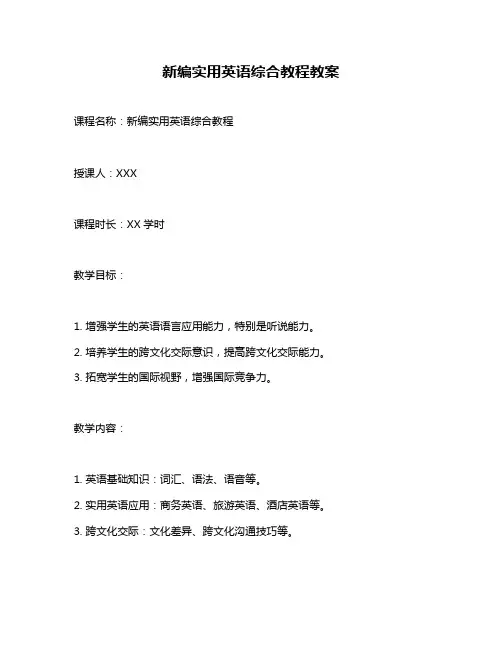
新编实用英语综合教程教案课程名称:新编实用英语综合教程授课人:XXX课程时长:XX学时教学目标:1. 增强学生的英语语言应用能力,特别是听说能力。
2. 培养学生的跨文化交际意识,提高跨文化交际能力。
3. 拓宽学生的国际视野,增强国际竞争力。
教学内容:1. 英语基础知识:词汇、语法、语音等。
2. 实用英语应用:商务英语、旅游英语、酒店英语等。
3. 跨文化交际:文化差异、跨文化沟通技巧等。
教学难点与重点:难点:如何将英语基础知识与实际应用有效结合,提高学生的英语应用能力。
重点:跨文化交际能力的培养,以及如何增强学生的国际竞争力。
教具和多媒体资源:1. 投影仪、电脑、音响等多媒体设备。
2. 英语教材、练习册、听力材料等。
3. 跨文化交际案例、图片、视频等教学资源。
教学方法:1. 讲授法:讲授英语基础知识,如词汇、语法、语音等。
2. 案例分析法:通过分析实际案例,让学生了解跨文化交际的实际情况。
3. 小组讨论法:组织学生进行小组讨论,提高口语表达和交流能力。
4. 角色扮演法:通过角色扮演,模拟实际场景,提高学生的英语应用能力。
教学过程:1. 导入(5分钟):通过提问导入,检查学生预习情况,引起学生的兴趣。
2. 讲授新课(45分钟):讲解英语基础知识和实用英语应用,结合案例分析,引导学生思考。
3. 巩固练习(20分钟):组织学生进行小组讨论、角色扮演等活动,巩固所学内容。
4. 归纳小结(10分钟):总结本节课的重点内容,对学生的表现进行评价,给出建议和指导。
评价与反馈:1. 设计评价策略:通过课堂表现、小组讨论、角色扮演等活动,以及课后作业和测试等形式进行评价。
新编实用英语综合教程教案教案:新编实用英语综合教程第一课:问候与介绍教学目标:1.学会用英语问候与介绍他人。
2.学习相关的词汇和句型。
3.提高口语表达能力。
教学重点:1.学习常用的问候方式。
2.学习如何介绍他人。
3.练习口语表达能力。
教学准备:1.教师准备教材及配套课件。
2.确保教室上课环境整洁。
3.准备相关的课堂活动。
教学过程:步骤一:导入(5分钟)教师向学生打招呼,并用英语问候全班学生。
然后询问学生如何用英语问候他人。
步骤二:新知呈现(10分钟)教师提供一些常用的问候方式,并解释其用法和含义。
例如:“How are you?”、“What’s up?”、“How’s it going?”等。
然后教师通过演示的方式向学生展示如何用这些问候方式与他人进行交流。
步骤三:对话练习(10分钟)教师分发练习卡片,学生们分成小组进行对话练习。
每组学生轮流扮演不同的角色,进行问候和介绍的对话练习。
教师可以在课堂辅助学生,纠正他们的发音和语法错误。
步骤四:分组活动(15分钟)教师将学生分成小组,每个小组的成员都有一个袋子,里面放有一些物品。
小组成员通过轮流拿东西,然后用自己的话介绍拿到的物品。
其他组员可以提问或者给出评论。
教师可以在活动过程中引导学生使用相关的句型和表达方式。
步骤五:练习评价(10分钟)教师提供一些练习题,要求学生用英语回答。
例如:“How do you usually greet your friends?”、“How would you introduce yourself in English?”等。
学生们可以在书写或者口头表达上回答问题。
步骤六:小结复习(5分钟)教师对本节课的内容做一个小结,并提醒学生下节课的学习内容。
第二课:购物与点餐教学目标:1.学会用英语购物和点餐。
2.学习相关的词汇和句型。
3.提高口语表达能力。
教学重点:1.学习如何用英语购物和点餐。
2.学习相关的词汇和句型。
综合英语教程3 教案教案标题:综合英语教程3 教案教案目标:1. 提高学生的综合英语能力,包括听、说、读、写和翻译。
2. 培养学生的跨文化交际能力和批判性思维能力。
3. 帮助学生掌握综合英语教程3所涉及的语法、词汇和语言技能。
教学重点:1. 学习并掌握综合英语教程3中的关键词汇和短语。
2. 提高学生的听力和口语表达能力,通过听力练习和口语对话的训练。
3. 培养学生的阅读理解能力,通过阅读教材中的文章和相关练习。
4. 提升学生的写作和翻译能力,通过书面作业和翻译练习。
教学准备:1. 综合英语教程3教材和相关教学资源。
2. 多媒体设备和投影仪。
3. 学生练习册和作业本。
4. 教学课件和教学录音。
教学步骤:第一课时:1. 导入:通过展示一张关于主题的图片引起学生的兴趣。
2. 介绍本课的主题和目标,并提出问题激发学生思考。
3. 听力训练:播放录音,让学生听取关于本课主题的对话,并回答问题。
4. 口语练习:分组讨论本课主题,并进行角色扮演对话练习。
5. 阅读理解:让学生阅读教材中的一篇文章,并回答相关问题。
6. 语法讲解:介绍本课的重点语法知识,并进行例句分析和练习。
第二课时:1. 复习上节课的重点内容,通过小组讨论和问题回答。
2. 听力练习:播放录音,让学生听取一段对话,并完成相关练习。
3. 口语训练:组织学生进行小组讨论,讨论与本课主题相关的话题,并进行口语表达练习。
4. 阅读理解:让学生阅读教材中的一篇文章,并回答相关问题。
5. 书面作业:布置一篇与本课主题相关的写作作业,并在下节课检查。
第三课时:1. 复习上节课的重点内容,通过问题回答和小组讨论。
2. 听力训练:播放录音,让学生听取一段对话,并回答相关问题。
3. 口语练习:组织学生进行小组讨论,讨论与本课主题相关的话题,并进行口语表达练习。
4. 阅读理解:让学生阅读教材中的一篇文章,并回答相关问题。
5. 翻译练习:布置一篇与本课主题相关的翻译练习,并在下节课检查。
一、教学目标1. 知识目标:- 学生能够掌握本节课的核心词汇和短语。
- 学生能够理解并运用所学语法知识进行日常交流。
- 学生能够通过阅读和听力练习,提高英语阅读理解能力。
2. 能力目标:- 学生能够运用所学知识进行口语表达和听力理解。
- 学生能够通过小组合作和讨论,提高团队协作能力。
- 学生能够通过课外阅读和自主学习,培养自主学习能力。
3. 情感目标:- 学生能够树立自信心,积极参与课堂活动。
- 学生能够对英语学习产生浓厚的兴趣。
- 学生能够培养跨文化交际意识。
二、教学内容1. 课文内容:根据教学进度选择合适的课文内容。
2. 语法知识:本节课要学习的语法知识。
3. 词汇:本节课要学习的核心词汇和短语。
4. 听力材料:与本节课内容相关的听力材料。
5. 阅读材料:与本节课内容相关的阅读材料。
三、教学过程1. 导入新课- 通过图片、视频或歌曲等方式导入新课,激发学生的学习兴趣。
2. 词汇教学- 教师带领学生朗读课文,学习课文中的核心词汇和短语。
- 通过游戏、练习等方式帮助学生记忆和运用所学词汇。
3. 语法教学- 教师讲解本节课的语法知识,通过例句、练习等方式帮助学生理解和掌握。
4. 听力训练- 播放听力材料,让学生进行听力练习。
- 教师点评学生的听力理解情况,并针对问题进行讲解。
5. 阅读理解- 学生阅读课文或阅读材料,完成相关练习。
- 教师点评学生的阅读理解情况,并针对问题进行讲解。
6. 口语表达- 学生进行口语练习,如角色扮演、小组讨论等。
- 教师点评学生的口语表达,并给予指导。
7. 总结与拓展- 教师对本节课的学习内容进行总结,强调重点和难点。
- 布置课后作业,如背诵课文、预习下一节课内容等。
四、教学评价1. 课堂表现:观察学生在课堂上的参与度、合作能力、表达能力等。
2. 作业完成情况:检查学生的课后作业,了解学生的学习效果。
3. 听力测试:定期进行听力测试,评估学生的听力理解能力。
4. 口语测试:进行口语测试,评估学生的口语表达能力。
综合英语教案一、教学目标1.知识目标:掌握本单元的重点词汇和短语,理解课文内容,了解相关的文化背景。
2.能力目标:培养学生的阅读理解能力、听力理解能力、口语表达能力和写作能力。
3.情感目标:培养学生的跨文化意识,提高对英语学习的兴趣和积极性。
二、教学内容本单元主要围绕“旅行”这一主题展开,包括阅读、听力、口语和写作四个部分。
三、教学步骤1.导入(5分钟)通过展示一些关于旅行的图片或视频,引导学生进入本单元的主题。
提出问题,让学生思考旅行的好处和意义,激发学生的学习兴趣。
2.阅读(20分钟)让学生阅读本单元的课文,了解文章的主要内容和结构。
在阅读过程中,引导学生注意重点词汇和短语的用法,以及文章中的文化背景知识。
同时,鼓励学生提出问题和疑惑,及时解答学生的问题。
3.听力(10分钟)播放本单元的听力材料,让学生了解听力内容。
在播放过程中,引导学生注意听力技巧和方法的运用,如抓住关键词、预测答案等。
同时,鼓励学生多听多练,提高听力水平。
4.口语(15分钟)组织学生进行口语练习,围绕“旅行”这一主题展开讨论。
让学生分组进行对话练习,鼓励学生运用所学词汇和短语进行交流和表达。
同时,引导学生注意语音语调的准确性和流利性。
5.写作(10分钟)让学生根据本单元的主题和所学知识,写一篇关于旅行的短文。
在写作过程中,引导学生注意文章的结构和逻辑性,以及语言的准确性和流畅性。
同时,鼓励学生多写多练,提高写作水平。
6.总结与作业(5分钟)对本节课的教学内容进行总结,强调重点和难点。
布置相关作业,让学生课后继续巩固所学知识。
同时,鼓励学生多阅读、多听、多说、多写,提高英语综合应用能力。
英语读写综合教案初中一、教学目标:1. 知识目标:(1)学生能够掌握一定的英语词汇和语法知识。
(2)学生能够理解阅读材料的基本内容,具备一定的阅读理解能力。
(3)学生能够运用所学知识进行简单的英语写作。
2. 能力目标:(1)学生能够具备一定的英语听、说、读、写能力。
(2)学生能够通过阅读获取信息,提高阅读理解能力。
(3)学生能够运用英语进行日常交流和表达。
3. 情感目标:(1)激发学生学习英语的兴趣,培养学生的学习积极性。
(2)培养学生团结协作、积极参与的精神风貌。
二、教学内容:1. 词汇:本节课将引入新的词汇,如:actor, actress, movie, interesting等。
2. 语法:一般现在时态的肯定句和否定句。
3. 阅读材料:一篇关于电影的文章。
4. 写作任务:以“我最喜欢的电影”为主题,写一篇短文。
三、教学过程:1. 热身活动(5分钟)(1)教师与学生进行简单的英语对话,检查学生的英语水平。
(2)学生进行小组活动,用英语介绍自己的兴趣爱好。
2. 词汇学习(10分钟)(1)教师展示新词汇,引导学生跟读并记忆。
(2)学生进行词汇练习,巩固所学词汇。
3. 阅读理解(15分钟)(1)教师发放阅读材料,学生自主阅读。
(2)教师提问,检查学生的阅读理解能力。
(3)学生进行小组讨论,分享阅读心得。
4. 写作指导(10分钟)(1)教师引导学生思考写作主题,指导学生进行写作。
(2)学生进行写作练习,教师巡回指导。
5. 展示与评价(10分钟)(1)学生展示自己的写作成果,进行自评和互评。
(2)教师对学生的写作进行评价,给予鼓励和建议。
6. 总结与作业(5分钟)(1)教师对本节课的内容进行总结,强调重点。
(2)布置作业:复习本节课的词汇和语法,预习下一节课的内容。
四、教学策略:1. 任务型教学法:通过小组活动和写作任务,激发学生的学习兴趣,培养学生的合作精神。
2. 交际式教学法:教师与学生进行英语对话,提高学生的听说能力。
小学英语综合实践课教案教学目标:1. 培养学生的英语听、说、读、写能力,提高英语综合运用能力。
2. 培养学生的团队协作精神和沟通能力。
3. 激发学生对英语学习的兴趣和积极性。
教学重点:1. 通过实践活动,让学生在实际情境中运用英语进行交流。
2. 培养学生的英语思维能力和创新意识。
教学难点:1. 学生在实际情境中运用英语进行交流的能力。
2. 学生对英语词汇和语法的掌握程度。
教学准备:1. 教材、教学课件、教学道具等。
2. 分组,每组45人,确保每个学生都能参与到实践活动中。
教学过程:一、导入1. 教师通过播放一段与主题相关的英语视频,激发学生的兴趣。
2. 教师引导学生讨论视频内容,并引出本节课的主题。
二、实践活动1. 教师将学生分成小组,每组选择一个主题进行实践。
2. 各小组在教师的指导下,通过查阅资料、讨论、制作PPT等方式,完成实践任务。
3. 各小组向全班展示实践成果,并进行小组互评。
2. 学生分享自己在实践中的体会和感受,提出改进意见。
3. 教师对学生的表现进行评价,鼓励学生在今后的学习中继续努力。
四、作业布置1. 教师布置与本节课主题相关的英语写作任务,要求学生运用所学知识进行创作。
2. 学生在课后完成作业,并上交给教师批改。
教学反思:本节课通过实践活动,让学生在实际情境中运用英语进行交流,培养了学生的英语听、说、读、写能力。
同时,通过小组合作,培养了学生的团队协作精神和沟通能力。
在教学过程中,教师应关注学生的学习状态,及时给予指导和帮助,确保每个学生都能参与到实践活动中。
在今后的教学中,教师应继续探索和实践有效的教学方法,提高学生的英语综合运用能力。
教学过程(续):五、拓展延伸1. 教师引导学生思考如何将本节课所学知识应用到日常生活中。
2. 学生分享自己的见解和想法,教师给予鼓励和指导。
3. 教师布置拓展任务,要求学生运用所学知识解决实际问题。
六、课后辅导1. 教师针对学生在课堂上的表现,给予个性化的辅导和建议。
任教课程年月日Unit 5一、授课时间:第9周3次课;第10周2次课二.授课类型:课文分析8课时;习题讲解2课时三.授课题目:Silent Spring四.授课时数:10五.教学目的和要求:通过讲授课文使大学生了解有关环境保护的有关知识,学会用英语解释句子以达到学以致用的目的。
要求学生主动地预习课文,课前准备练习,学会分析文章体裁和进行段落划分。
六.教学重点和难点:1)背景知识的传授:About the author;2)文章的体裁分析及段落划分;3)语言点的理解:Word study: to change; to exchange; beside; besides; except; used to; be used to; to shiver; to tremble; to shake; to shudderGrammar Focus: Study and learn how the words such and so are used; Study such patterns as considering…; given time; it is no accident that; it is not my contention that.七.教学基本内容和纲要Part One Warm – up1.1 W arm-up Questions1. What is the message given to us in the essay? What are Rachel Carson’s main arguments? Have they stood the test of time?2. We are faced with all kinds of environmental problems nowadays. But what is the one that Rachel Carson dealt with in her book Silent Spring?3. How do chemicals affect the environment and people?4. Does Carson mean that insecticides should never be used in agriculture?1.2 Define the following words and phrases1. be geared to2.introduce…into3. a great variety of…4.hold sth within bounds5.built-in6.check7. a limit on…8.set the stage for任教课程年月日9.explosive (increases)10.live on (wheat)11.a/another factor in…is…Part Two Background Information2.1 Rachel Carson (1907-1964) biologist, writer, ecologist1. intense love for nature since her childhood→“Humans have now acquired a fateful power to alter and to destroy nature. But Man is a part of nature, and his war against nature is inevitably a war against himself.”―Rachel CarsonShe was once bitterly attacked:“an anti-humanitarian crank, a priestess of nature, and a hysterical woman”But she courageously went on fighting until her idea caught on and more and more people joined in.→the mother of modern environmental movementAbout the book:1. When was it published?2. Who was the author?3. What is it about? What is its central argument?4. How was it received?5. How significant is it now?6. Does it still make sense now?Part Three T ext Appreciation3.1 Text Analysis1.Questions for thinking:a.What can you infer about Carson’s view of the relation between man and nature?b.Was her view common in her time?c.How do you arrive at this inference?3.1.2 S tructure of the textPart I: paras.1-6a town before & after the disasterPart II: paras. 7-9cause of the disaster: chemicalsPart III: paras. 10-14character & impact of man’s tampering with naturePart IV: paras. 15-18reasons why pesticides fail to solve the pest problemPart V: paras. 19-24cause of modern pest problem and possible solutions任教课程年月日Part VI: para. 25conclusionLogic & T echniqueWhat: from interest to concern descriptionHow: from general to specific expositionfrom nature to manWhy: from effect to cause argumentationHow: from cause to solution exposition & argumentationRelevant questions:1. Why did Carson devote a whole paragraph to describe the spreading of species in nature before she mentioned man’s role in the process?2 Did she always first describe the mechanisms in nature before talking about man’s tampering with nature?3. Why did she present her ideas in this way? What’s her hidden argument?3.1.3 Detailed Analysis of the textPart I: Main IdeaContrast: a town before & after the disasterBefore AfterColor ColorSound SoundMotion MotionOverall impression: Overall impression:vibrant, lifeless,harmonious, deserted,beautiful awfulPart II: Discussion1.Why did the author paint such a beautiful picture of a non-existent town?2.What was she trying to appeal to?Part III: Discussion1. How has man changed the relation between organisms and their surroundings?Human NatureDirection: Direction:life →environment environment →lifeSpeed: Speed:Character: destructive Character: adaptativeirrecoverable2. In what way has man’s power changed in character?(para. 11)3. How do chemicals affect our life? (para. 11)“passing from one to anotherin a chain of poisoning and death”任教课程年月日4. What are the two examples given by the author as man’s tampering with nature? (paras. 11-13)5. Why is man’s change of the world particularly devastating? (paras. 12-14)Part IV: Discussion1. Why are pesticides not a good solution? (3 reasons)They kill indiscriminately, reducing biodiversity. (para. 16)They contaminate the entire environment. (para. 16)–residual effectThey couldn’t solve the pest problem. (para. 17)–resistance to chemicals–resurgence induced by pesticides2. What does the “endless spiral” refer to? (para. 17)3. What does the author mean by saying “all life is caught up in its violent crossfire”? (para. 17)4. What is the author’s attitude towards man’s use of che micals? How is it implied?Rhetorical questions:“Can anyone believe it is … ?”(para. 16)“How could intelligent beings…?” (para. 18)Part V: Discussion1. What principles should we follow to solve the pest problem? (para. 19)2. How did the pest problem come into being?intensification of agriculture (para. 20)invasion of imported species (paras. 21-23)3. Does spreading of organisms to new places happen in nature? How does it happen? What is the primary factor in this natural process?geological element, i.e. separating and rejoining of lands which took millions of years to complete (para. 21)4. What are the sensible measures to solve the pest problem? (para. 24)to avoid suppressing “pests”to get more knowledgeto promote an even balance5. In what ways have we done wrong in using chemicals?3.2 Writing Devices1. What is good writing?Her measured, carefully-worded (language) yet passionate prose (passion, love) was all the more damning because she, herself, was a scientist (ideas; information).2. How can we write with power and precision?2.1 EloquenceParallels任教课程年月日…until they emerge and combine into new forms that kill vegetation, sicken cattle, and work unknown harm on those who drink from once pure wells. (para. 11)…to still the song of birds and the leaping of fish, to coat the leaves with a deadly film, and to linger on in soil… (para. 16)Rhetorical questionsCan anyone believe…? (para. 16)How could intelligent beings… ? (para. 18)Antitheses:(juxtaposition of contrasting ideas in one grammatical structure)The rapidity of change follows the impetuous pace of man rather than the deliberate pace of nature. (para. 13)…this imagined tragedy may easily become a harsh reality we all shall know. (para. 8)2.2 PrecisionQualifying expressions:To a large extent, the physical form and the habits of theearth’s vegetation and its animal life have beenmolded by the environment. (para. 10)This pollution is for the most part irrecoverable. (para. 11)And even this, were it by some miracle possible,would befutile. (para. 14)Special verbs:n.–v.: flame, coat, line adj.–v.: still, brown, damp3.3 Sentence Paraphrase1. There was once a town in the heart of America where all life seemed to live in harmony with it surroundings.Once upon a time there was a town in the central part of America where all living things seemed to exist peacefully with their environment.2. In autumn, oak and maple and birch set up a blaze of color that flamed and flickered across a background of pines.In autumn, the oak, maple and birch trees turned yellow, red or brown, making a beautiful show of colors against the dark green of pine trees.3.Then some evil spell settled on the community: mysterious diseases swept the flocks of chickens; the cattle and sheep sickened and died.Then, as if by some evil power, disease struck the community: strange diseases quickly struck down large numbers of chicken; the cattle and sheep became ill and died.4.The feeding stations in the backyards were deserted.No birds came to eat or drink what was there at the feeding stations.5.On the mornings that had once throbbed(有规律地颤动) with the dawn chorus of scores of任教课程年月日bird voices there was now no sound;The morning air used to vibrate with the singing of birds, but there was now no sound…6.a harsh reality we all shall know.some serious consequence that we all have to face7. This book is an attempt to explain:This book, Silent Spring, intends to explain what has caused the disasters in many towns in America.8. a history of interaction between living things and their surroundingsa history of how living things and their environment affect and relate to each other.9.T o a large extent, the physical form and the habits of the earth’s vegetation and its animal life have been molded by the environment.The physical features and habits of the living things on earth have been greatly shaped by their surroundings.10. Considering the whole span of earthly time, the opposite effect, in which life actually modifies its surroundings, has been relatively slight.When we think of the long history of life on earth, the degree living things affect their environment has been insignificant as compared with the effect of the environment on plant and animal life.11.but it has changed in characterbut the nature of this power to alter the environment has changed.12. This pollution is for the most part irrecoverable.In most cases, the polluted air, soil, rivers and the sea cannot be restored to their original natural state.13. Or they pass mysteriously by underground streams until they emerge and combine into new forms that kill vegetation, sicken cattle, and work unknown harm on those who drink from once pure wells.Or they get deeper into underground streams, undergo some chemical process somewhere, and then become new substances that contaminate wells, kill plants and make cattle as well as people that drink the water sick.14. The rapid change follows the impetuous pace of man rather than the deliberate pace of nature.Man is changing nature rapidly while nature adjusts to the changes slowly. Therefore adjustment can never keep up with change, and anew balance between living things and their environment can hardly be reached.15. The chemicals are the synthetic creations of man’s inventive mind, having no counterparts in nature.Nature does not produce such things as chemicals. They are man-made and the result of man’s creative power.16. And even this, were it by some miracle possible, would be futile, for the new chemicals come from our laboratories in an endless stream;It would take some magic power to make living things adjust to these chemicals in the life of generations. Even if this were possible, it would be useless, because new chemicals are continuously being created and produced.任教课程年月日17. to still the song of birds and the leaping of fish, to coat the leaves with a deadly film, and to linger on the soilto kill the birds and fish, to cover the leaves with a thin layer of death-causing chemicals and to stay in soil for a long time18. - all this though the intended target may be only a few weeds or insects.all these serious consequences come about perhaps just because man wants to destroy a few weeds or insects.Part Four Language Study4.1 Phrases and ExpressionsTranslation1. 化学制品在农业上被广泛地、无区别地使用。